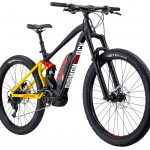The word inverter is a general term used the describe the function of converting DC to AC. This is because the energy storage is nearly always DC (i.e. a battery) but you need mains out which is of course 230Vac for your battery charger.
In that respect almost any inverter will do the job but make sure that the battery capacity of the inverter you buy is at least 150% of your bike battery. This way you are guaranteed to get at least one full recharge out of it before it's flat. Many inverters can be powered from an external 12V (like a car battery) which means you don't have the worry of the above.
The other thing to check is that the inverter can supply enough power (VA rating). Your charger is only likely to be 100VA or so and even the most basic inverters are usually capable of this. Again make sure you have 50% in hand so you would need a VA rating of at least 150VA for a 100VA charger. If the term VA confuses you , you can just think of it was watts as they are almost the same thing for what we are talking about here.
I agree an inverter is massively cheaper than buying a second battery.
Actually the most efficient way to do this is with a 12V to 36V battery charger. You can plug this into your car etc and recharge your bike at will without having to go through the DC to AC inversion. The difficulty is that using an aftermarket charger will probably screw your battery warranty, it must be optimised for LI-Ion charging and connectors etc will undoubtedly need to be changed. But they are available.
This guy has done something similar using a solar panel to charge his e-bike...
The 12V to 36V charger is an HP812 but it looks a bit tricky to find in the UK.
http://www.glowwormbicycles.com.au/collections/accessories/products/ezee-battery-charger-12v-to-36v-car-charger





